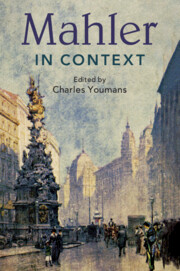Book contents
- Mahler in Context
- Composers in Context
- Mahler in Context
- Copyright page
- Dedication
- Contents
- Figures
- Music Examples
- Notes on Contributors
- Preface and Acknowledgments
- Abbreviations
- Part I Formation
- Chapter 1 Family Life
- Chapter 2 A Childhood in Bohemia
- Chapter 3 Music in Iglau, 1860–1875
- Chapter 4 Student Culture in 1870s Vienna
- Chapter 5 Viennese Musical Associates, 1875–1883
- Chapter 6 Becoming a Conductor
- Chapter 7 Between “Thrice Homeless” and “To the Germans in Austria”
- Part II Performance
- Part III Creation
- Part IV Mind, Body, Spirit
- Part V Influence
- Further Reading
- Index
Chapter 7 - Between “Thrice Homeless” and “To the Germans in Austria”
Political Conditions in Mahler’s Europe
from Part I - Formation
Published online by Cambridge University Press: 18 December 2020
- Mahler in Context
- Composers in Context
- Mahler in Context
- Copyright page
- Dedication
- Contents
- Figures
- Music Examples
- Notes on Contributors
- Preface and Acknowledgments
- Abbreviations
- Part I Formation
- Chapter 1 Family Life
- Chapter 2 A Childhood in Bohemia
- Chapter 3 Music in Iglau, 1860–1875
- Chapter 4 Student Culture in 1870s Vienna
- Chapter 5 Viennese Musical Associates, 1875–1883
- Chapter 6 Becoming a Conductor
- Chapter 7 Between “Thrice Homeless” and “To the Germans in Austria”
- Part II Performance
- Part III Creation
- Part IV Mind, Body, Spirit
- Part V Influence
- Further Reading
- Index
Summary
The stylistic heterogeneity of Mahler’s compositions calls to mind the linguistic and ethnic diversity of the regions in Central and Eastern Europe where he worked most of his life. In particular, the ethnic and cultural diversity of Vienna resonated with his own sense that he embodied a multifarious identity, one that both allowed him to see the world from multiple perspectives and forced him to deal with a range of conflicts and prejudices. In this chapter, Mahler’s famous remark on his multifaceted sense of alienation – that he was “a Bohemian among the Austrians, an Austrian among the Germans, and a Jew in the entire world” – is teased apart into its components, with commentary on the implications of each element of his identity in Vienna ca. 1900. The third identity, the most difficult to grasp, is approached here through the ideas of the historian Theodor Mommsen, whose conception of the shared cultural heritage of the two realms had a wide impact.
- Type
- Chapter
- Information
- Mahler in Context , pp. 56 - 62Publisher: Cambridge University PressPrint publication year: 2020

